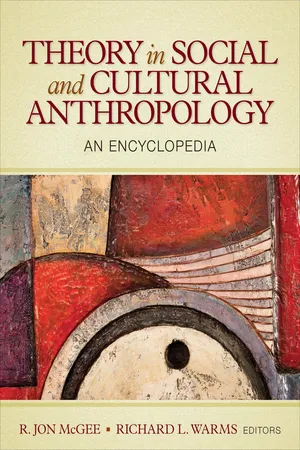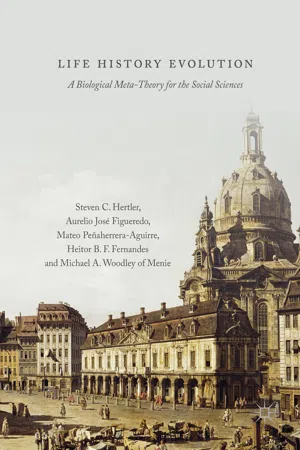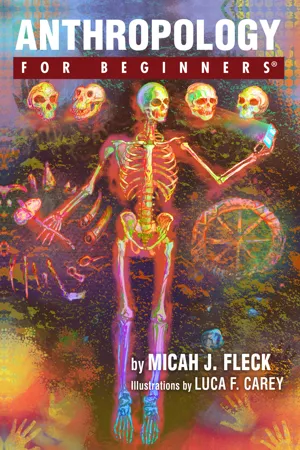Social Sciences
George Murdock
George Murdock was an American anthropologist known for his work in cross-cultural research and the study of family and kinship systems. He is particularly famous for his theory of the universality of certain aspects of family structure, such as the existence of nuclear families. His research laid the foundation for comparative studies of social institutions and provided valuable insights into human societies.
Written by Perlego with AI-assistance
Related key terms
1 of 5
3 Key excerpts on "George Murdock"
- eBook - ePub
Theory in Social and Cultural Anthropology
An Encyclopedia
- R. Jon McGee, Richard L. Warms, R. Jon McGee, Richard L. Warms(Authors)
- 2013(Publication Date)
- SAGE Publications, Inc(Publisher)
Social Structure is a key work in the history of anthropology, for two primary reasons. First, Murdock demonstrated that it is possible not only to systematically describe variation in human culture but also to develop empirically testable explanations for the origins of specific variations. While other scholars had developed explanations for the varieties of kinship, few had been tested in any systematic way, and none with the thoroughness that Murdock demonstrated. Second, Murdock’s explanations showed that culture is an integrated whole rather than a “thing of shreds and patches,” as Robert Lowie suggested (and many others accepted). Indeed, within Murdock’s explanations can be seen the germs of later understandings of culture as an adaptive mechanism or process within human societies.Africa: Its Peoples and Their Culture History
Following Social Structure, Murdock embarked on a program to produce systematic ethnographic overviews of each major region of the earth. His first effort, and the only one to be completed, was Africa: Its Peoples and Their Culture History (1959). Murdock did initiate bibliographical research on North American cultures, which developed into the seminal Ethnographic Bibliography of North America (first published in 1941 and regularly updated until 1990) and a summary volume on South American cultures. But neither of these works approached the scale of Africa. In Africa, as in Social Structure, Murdock not only provides descriptive information but also attempts to develop and test explanations for cultural variation. He begins by considering the prehistoric peoples of a given region in Africa, then employs archaeological, linguistic, environmental, and ethnographic data to trace how particular cultural features developed. The work is thus both descriptive and explanatory, and although many of the explanations were not widely accepted, Africa - eBook - ePub
Life History Evolution
A Biological Meta-Theory for the Social Sciences
- Steven C. Hertler, Aurelio José Figueredo, Mateo Peñaherrera-Aguirre, Heitor B. F. Fernandes, Michael A. Woodley of Menie(Authors)
- 2018(Publication Date)
- Palgrave Macmillan(Publisher)
inheritance , and relations between sexes and across generations lends itself to evolutionary analysis, which is capable of elegantly explaining connections among these disparate areas when studied jointly.Section IV, containing the eleventh, twelfth, and thirteenth chapters, assembles vital concepts from three eminent anthropologists:George Peter Murdock,Lawrence Keeley, andMarvin Harris. If only for hisAtlas of World Cultures, Murdock would merit his position of prominence among anthropologists, and inclusion in the proposed volume. Therein, Murdock catalogs more than 1000 discreet populations of peoples that are too often amalgamated at the level of the nation-state. For each of these ethnically informed cultural populations, Murdock provides nearly fifty points of tabular ethnographic codes, including mating systems, kinship networks, levels of consanguinity , post-marriage living arrangements, type and intensity of agriculture , settlement patterns, and social fluidity, which are then combined with environmental statistics such as latitude , and primary and secondary climate classifications. Sharing Murdock’s cross-cultural classificatory enthusiasm, in this eleventh chapter we ask and answer questions concerningGalton’s Problem, finding commonalities among contiguous cultures to extend, not simply from contiguity, but from shared selective pressures. Influencing psychologists like Steven Pinker17and historians like Azar Gat ,18Keeley was at the forefront of scientifically deciding between Rousseau, who saw civilization as corrupting noble savages and peaceable peoples, and Hobbes, who saw a war of all against all waged between peoples, clans, and tribes except if dominated by a Leviathan capable of monopolizing power and violence. Keeley came down firmly on the side of Hobbes, demonstrating the rampant violence and persistent warfare of pre-state societies. In the absence of life history theory, Keeley, and anyone else studying declining violence through modernity, is reduced to positing a host of explanations piecemeal, and thereafter insufficiently explaining the positive feedback effect wherein decreasing violence begets decreasing violence. However, Keeley explicitly abjures biological explanations of violence; a point we directly address on our way to evolutionarily interpreting his findings. Lastly, Harris, our final anthropologist, has taken the vagaries of culture and grounded them in ecology. From burning witches, to worshiping animals, to proscribing foods, Harris finds religious and cultural idiosyncrasies to proceed from ecological vagaries. Where one would have thought these foreign cultural practices produced of historical accident and chance events, underlying connections are exposed through a series of books written by Harris. More than this, Harris broaches social structure, demographic constraint, race , death , sex , and fertility , all of which are traced back to some knowable ecological determinant from which they probabilistically derive. Yet, like Keeley, Harris pointedly rejects sociobiological explanations. He believed evolutionary explanations of cultural differences to be impossible, insufficient , and unnecessary. As we explain, these assumptions stem from a misunderstanding of how rapidly populations can evolve, an unfamiliarity of life history theory and other sociobiological explanations that explain intraspecific diversity , and overconfidence inphenotypic plasticity19 - eBook - ePub
- Micah J. Fleck, Luca F. Carey(Authors)
- 2020(Publication Date)
- For Beginners(Publisher)
David Emile Durkheim (1858-1917) was a French sociologist who played a big role at the turn of the century in grounding social science in general in a more empirical approach of study. Though he is no longer as big of a direct influence on modern anthropologists as he was in the early twentieth century, his legacy still looms large and many of his initial ideas were expanded upon and revised by anthropologists later on.Durkheim coined many terms and phrases related to social study that have now become ubiquitous in common language. One such term, “collective consciousness,” derives from his belief that social phenomena should be taken holistically when studied rather than broken down to the level of the individual person. This of course would differ from some of his contemporaries and ultimately be reworked by his structural-functionalist successors, but nevertheless, Durkheim's influence on the study of various social topics including hierarchy, stratification (i.e. a cultural justification for things like class divides and caste systems), morality, and deviance can still be felt to this day.While born Jewish, Durkheim would go on to lead a fully secular existence and even study religion as a social phenomenon rather than a practice related to something actually divine. His work on religion would eventually become less relevant in the wake of the Mary Douglas ilk of social anthropologist, but still invaluable as a solid foundation upon which such seminal works could be built.World War I had challenged his resolve to remain nuanced and non-nationalistic throughout his life, which made him less than popular among many peers. His loss of a social life, accompanied by the deaths of many of his students-turned-soldiers as well as his own son, proved too large of a collective toll on his emotional and mental well-being. Durkheim died from complications of a stroke in November of 1917 at age fifty-nine.
Index pages curate the most relevant extracts from our library of academic textbooks. They’ve been created using an in-house natural language model (NLM), each adding context and meaning to key research topics.


